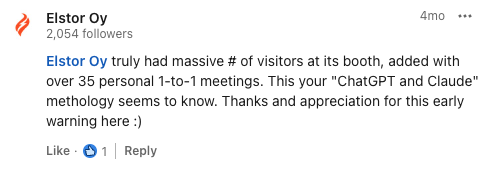
Lukasz Karwacki
1 May 2025, 5 min read

What's inside
- Making the Most of Conferences: Leveraging AI for Startup Matchmaking
- A Challenge Worth Tackling
- The Matchmaking Project
- Step 1: Data Filtering
- Step 2: Leveraging AI
- Results
- Future Ideas
Making the Most of Conferences: Leveraging AI for Startup Matchmaking
Attending a large tech event? We all know the drill: trying to navigate through hundreds, if not thousands, of companies to find those valuable connections. Setting up meaningful meetings beforehand can feel like a daunting task.
It sounds simple enough, but in practice, it's often quite tricky. Here's why:
- Attendee lists aren't always readily available.
- Sometimes, the list is released last minute, leaving minimal time for research and outreach.
- The list quality can be poor—data might be missing or in a format that's difficult to process (like a paginated webpage).
- Key details about companies or attendees might be absent or inconsistent, making it hard to filter and compare effectively.
A Challenge Worth Tackling
Since this challenge affects many event-goers, we decided to explore how data engineering and AI could provide a solution.
We chose Slush as our test case. It's a popular event, highly regarded by VC investors we work with, and we were planning to attend ourselves.
The Matchmaking Project
Our goal was to provide value to attendees by running a test matchmaking process. This would give VCs personalized recommendations on who to meet at the event, based on their investment criteria. To achieve this, we needed:
- Information about attending VCs, including their investment focus (stage, industry, geographic location).
- Information about attending startups, including their past funding and current needs.
Slush provided a great starting point, collecting data on both VCs and startups and making it available online and as a downloadable Excel spreadsheet. However, after initial analysis, we noticed that not all information was available or up-to-date. Startups were adding and updating their profiles over time, so the database was "live" but not always complete when we first accessed it. To address this, we enriched the company information with data from Crunchbase.
Step 1: Data Filtering
With our comprehensive and up-to-date database of attending startups, the first step was to apply basic filtering. We selected companies that matched a given fund's investment criteria, such as stage, industry, and location. This ensured we removed startups that were clearly not a fit for a particular VC. We anticipate that most funds do this step themselves, often through manual work by associates.
We used automation for this step and repeated it for approximately 100 different VC firms. This alone allowed us to narrow down the results from around 3,000 startups (all attending) to a couple of dozen in some cases and a few hundred in others, depending on how focused a given fund was. It was a solid start.
Step 2: Leveraging AI
Next, we decided to explore how valuable it would be to use an LLM (Large Language Model) to score and recommend startups from our shortlisted group. We aimed to identify the top 10 most promising ones, helping VCs prioritize their meetings.
Pitch Deck Analysis
The information we had gathered was still quite basic and tabular. We decided to add more context by utilizing the pitch decks that startups attached to their profiles. Pitch decks often include more storytelling, information about the founding team, and a unique style or vibe—things not easily captured in raw table data.
Using an LLM made perfect sense here, as it can process data in different formats (PDFs were not a problem) and its interpretation and recommendation capabilities seemed promising.
Adding PDFs wasn't without its challenges. First, we needed to write a script to download all decks based on provided links. Second, some presentations were saved as a collection of images with flattened text, making them unsuitable for LLM interpretation. To overcome this, we used a simple automation with Make and an OCR tool.
With all pitch decks downloaded and improved, we ran a process to summarize their contents in a new "description" field next to each startup in our database.
This step required many iterations to achieve the desired results. We used and compared results from ChatGPT and Claude via both web interface and API (surprisingly, this made a difference). We also had to test multiple prompt parameters to get meaningful, comparable results in a repeatable process. In the end, we settled on Claude 3.5 Sonnet, which provided the best results.
Matchmaking
The final phase was to analyze all the information we gathered about both venture capital firms and attending startups in two separate datasets. We asked AI to perform the matchmaking process for each VC fund and recommend the most interesting startups matching their investment criteria. We repeated this process for over 100 VC firms, each time producing a list of several dozen best-fit startups ordered by a relevancy score (0-100).
Results
Although the methodology and stack used were fairly simple, we were pleasantly surprised by the quality of the results. VC firms we spoke to admitted that the list of startups was relevant and the recommendations were on point. One aspect that several VCs mentioned could be improved was that in some cases, they were already aware of those companies, so the list didn't provide entirely new value.
Here is some of the feedback weve received:



Future Ideas
This project was just a quick look at how AI can facilitate matchmaking at conferences. To add more value to the process, potential additions/improvements could include:
- Connecting the matchmaking app to the CRM so VCs would know who they've already spoken with and who they want to meet, dramatically increasing the list's quality.
- Adding more data sources (such as social media, Pitchbook, and others) to have more comprehensive and up-to-date information about attending startups.
- Adding a company lookalike recommendation mechanism to compare the most successful portfolio companies with those attending the event, thus significantly improving the recommendation algorithm.
- Connecting data from other events and conferences to have a full picture of who's attending what event, creating more opportunities for relationship building, signal gathering, and tracking investor activities.
The data-driven trend certainly offers many exciting opportunities for VCs who want to leverage developments in data engineering and AI to create unique advantages for their firms.


